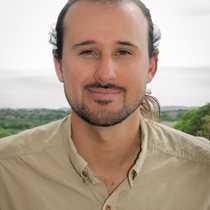Today the National Geographic Islander set its anchor shortly before sunrise after sailing a short distance from our previous stop. As the silhouette of Isabela Island’s Alcedo volcano transformed into the by now familiar arid landscape, it became clear that today we were planning to continue our exploration of the west coast of this the biggest island in this remote archipelago.
After breakfast we landed on a dark sand beach at Urbina Bay. Our plan was to explore the area and witness the evidence of a dramatic uplift that transformed the surroundings from a reef teeming with underwater life, into a dense forest where the remains of subaquatic organisms have been engulfed by mostly saltwater tolerant greenery. As we made our way along the rocky shore our progress was followed closely by a curious young Galapagos Hawk that kept landing on rocky outcrops, sometimes behind and sometimes ahead of one of our groups. As the tide slowly rolled in we spotted several blue footed boobies and striated herons going after small fish in the shallows.
Right before leaving the shoreline, a small shallow cove opened up ahead of us with a lonesome penguin sunning himself on a small rock while a Galapagos flightless cormorant came up for air in between short hunting dives, all under the scrutiny of the Galapagos Hawk who peered down from a tall boulder in the background.
Having passed skeletons of massive coral heads which now lay several feet above sea level and several Galapagos land iguanas who basked in the shade under the poisonous apple trees, we were surprised to find a Galapagos giant tortoise placidly resting in the shade near the landing.
This afternoon after having backtracked up north along the west coast of Isabela, we dropped anchor at Tagus Cove where in the footsteps of Darwin we hiked around a massive tuff cone crater. Many of our guests also took the opportunity to explore the shoreline above the waves with a stroll and below the waves while snorkeling, kayaking and aboard our Zodiacs. Galapagos marine Iguanas took a late afternoon snack in the shallows thanks to the low tide, while flightless cormorants nested just inshore. There was even a pair cormorants that has taken over one of the steps at the landing site and which seem to be doing very well incubating their two eggs in the algae lined nest.
As sunset drew near we witnessed Galapagos penguins make their landing close to their nesting sites as they called out to the partners.
The western sun illuminated the slopes of the tuff cones that surround the cove and as the bands of yellow orange became thinner, we made our way back to our home away from home. What a day!!!






